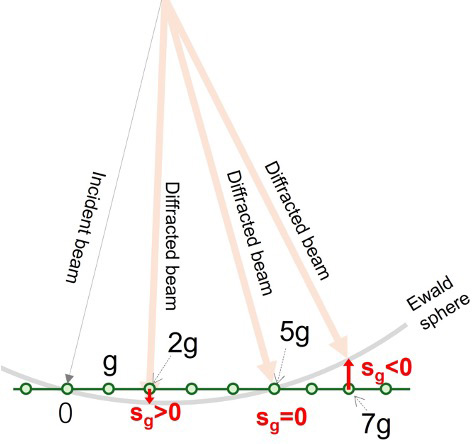excitation error
excitation error
"Excitation error", denoted as sg, means a deviation from a Bragg condition for a certain reflection g. The excitation error is defined as the distance from the reciprocal lattice point g to a point on the Ewald sphere measured along the propagation direction of the electron beam (usually perpendicular to the upper surface of the specimen).
The diffraction intensity varies with the excitation error. The intensity change curve is called the rocking curve. The rocking curve can be directly observed in a convergent-beam electron diffraction pattern.
When the Bragg condition is accurately satisfied, sg = 0. In the figure, sg is defined to be positive in the downward direction. Thus, when the reciprocal lattice point is located inside the Ewald sphere, sg> 0, whereas the reciprocal lattice point is located outside the Ewald sphere, sg< 0. sg is an observable quantity with units of inverse length.
The dimensionless parameter (tilt parameter) ω = sg×ξg, ξg being the extinction distance, is used instead of sg as a useful parameter in the theoretical treatment. However, it should be noted that ω is not experimentally measurable.

Fig. Schematic of the definition of positive and negative signs of excitation error.
sg=0 when the Ewald sphere passes through the reciprocal lattice point g, sg>0 when the reciprocal lattice point is inside the Ewald sphere, sg<0 when it is outside the Ewald sphere. In this figure, reflection 5g exactly satisfies the Bragg reflection and sg=0 .
Related Term(s)
Term(s) with "excitation error" in the description
Are you a medical professional or personnel engaged in medical care?
No
Please be reminded that these pages are not intended to provide the general public with information about the products.




